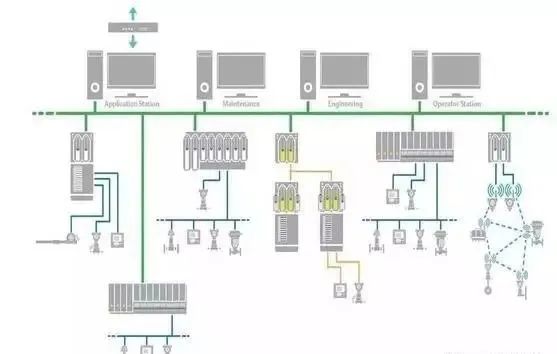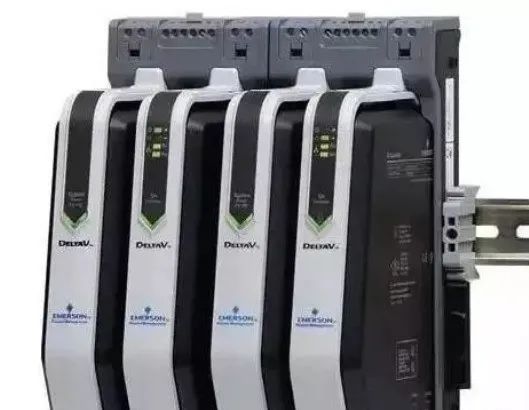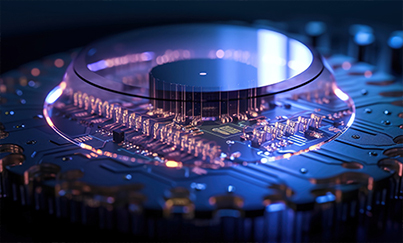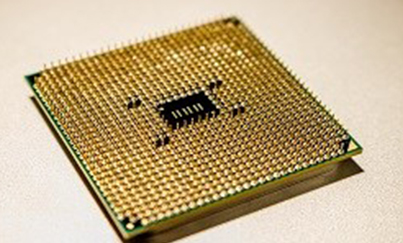Ⅰ. PLC
It has multiple functions, including continuous control from bottom to top and is located in the interrupt station, from switch quantity control to sequence control and transportation processing.
Multiple PLCs of the same type can be utilized as slave stations, and one PC can serve as the master station.
Another option for creating a PLC network is to utilize one PLC as the master station and several PLC s of the same type as slave stations. This is more practical than utilizing a PC as the master station since user programming may be done without knowing the communication protocol by just writing it in manual language.
The PLC grid acts both as a standalone DCS and as a subsystem of the DCS.
PLC is mainly used for sequential control in industrial processes, and the new PLC also has closed-loop control functions.
Ⅱ. DCS
The 4C (Communication, Computer , Control, ) monitoring technology is integrated into the distributed control system (DCS).
For big systems where communication is essential, use a top-to-bottom tree structure.
PID in the interruption station, the interruption station connects the computer with the field instrumentation and the control device, and there are also many parallel cables from the interruption station to the field instrumentation.
A/D—-D/A analog signal and a microprocessor are combined.
Two lines connect one instrument to the , and the control station connects it to the local area network (LAN).
Control (engineer station), operation (operator station), and field instrument are the three levels of the DCS (field measurement and control station). for the control of large-scale continuous processes, such petrochemicals, etc.
Ⅲ. How to choose between PLC and DCS system
Varied applications have different needs for the control system, thus how to choose between a Programmable Logic Controller (PLC) and a Distributed Control System (DCS) should be considered on a case-by-case basis.
The control system platform affects how an automated system satisfies the demands of production optimization, availability maintenance, and data collection. Inadequate planning when selecting a control system can also have an impact on future growth, process optimization, user satisfaction, and business earnings. The design team must take into account a number of elements in addition to some fundamental rules (such as how to govern the process), including installation, scalability, maintenance, and so on.
At the moment, DCS systems offer more economical scalability and are more likely to obtain a greater initial return on investment, even though PLC systems may be the most cost-effective for small equipment.
A is an industrial computer that manages motion control, high-speed packaging, bottling, and other manufacturing processes. PLCs now have more features than they did twenty years ago, which advantages small industries and installations more.
PLC typically runs independently, but it can also be integrated with other systems to make the connections that can be made through communication between them. Integration necessitates some degree of mapping between controllers because every has its own database. PLCs are thus particularly well suited for compact applications that don't call for a lot of expansion.
DCS systems distribute controllers throughout automation systems and offer standard interfaces, sophisticated controls, system-level databases, and information that is simple to communicate. Since large system applications are simpler to maintain over the course of a plant's life cycle, process technologies and rather large plants have historically been the principal uses for DCS.
The relay control principle is where the got its start. It keeps instructions for carrying out logical operations, sequence control, timing, counting, and other operations and uses digital input and output operations to control different kinds of machinery or manufacturing processes. The control program, which the user creates and beforehand stores in the PLC's user program memory, articulates the technological needs of the manufacturing process. When running, the content of the stored program is executed one by one to complete the operations required by the technological process.
Ⅳ. Comparison of PLC and DCS engineering analysis
The PLC CPU has a program counter that displays the program step's storage address. The program runs sequentially from the first step (step number is zero) to the last step (often the end instruction), increments the counter automatically each time a step is completed, and then loops back to the first step to repeat operations.
A scan cycle is the amount of time needed for a PLC to accomplish one cycle action. The cyclic scan period varies among PLC types and ranges from one microsecond to several tens of microseconds. DCS does not feature loop operations like the program counter. PLCs are less redundant than DCSs due to this as well.
Operational amplifiers provide the basis of DCS development. Function blocks represent all connections between functions and process variables (some DCS systems are called extruded blocks). The logic computation of switching quantity and the operation of analog quantity are where the performance of differs most. There is still a difference between the two, even if they later penetrate one another.
The algorithm functions of PLC control loops have been substantially improved since the 1980s, along with logic operations, but PLC still employs ladder diagram programming, which makes programming more difficult and analog operations less obvious. However, when it comes to solving logic, it demonstrates the benefit of being quick; it takes less than one millisecond to solve a 1k logic program. It treats 16-bit (and 32-bit) inputs as analog quantities and all other inputs as switch quantities.
All inputs are treated as analog quantities by the DCS, and the switch quantity is 1. The time it takes to solve a logic problem ranges from few milliseconds to hundreds of microseconds. When compared to the operating time of DCS, PLC can solve a pid operation in tens of milliseconds.
PLC may not be very demanding in terms of grounding resistance, while DCS has to be under a few ohms (usually below 4 ohms). Also crucial is analog isolation.
The cost of PLC is less expensive than the cost of DCS for a system with the same number of points (about 40 percent can be saved). PLC's maintenance costs are significantly lower than those of DCS since it does not require a specific operating station and employs universal software and hardware. It is better to use a PLC if the controlled object is mostly an equipment chain with few loops.
It is advisable to use DCS if the control is primarily analog and there are several function operations. Regarding the redundancy of controllers, I/O boards, communication networks, etc., some complex operations, and specific industry requirements, DCS is far superior to PLC, It is simpler to create the enterprise's management information system because PLC uses general monitoring software.
In general, discrete and process manufacturing can benefit from PLC and DCS systems, respectively. a PLC-based discrete manufacturing facility with distinct production units that are typically used to finish part assembly, such as labeling, filling, or grinding. Process manufacturing facilities manufacture according to a recipe rather than piecemeal in a continuous and batch process, frequently using automated technology. DCS automation systems are used in large continuous processing facilities like chemical and oil refineries. In hybrid applications, PLC and DCS systems are frequently used. The size of the process, scalability and future update plans, integration requirements, functionality, high availability, and return on investment over the whole life cycle of the plant facility must all be taken into account when choosing a controller for an application.
Ⅴ. Relevant factors that influence how a decision is made
Process scale: How many I/O (input/output) points are necessary? A PLC system is better appropriate for small systems (300 I/O points) because they may have a smaller budget. Applying the DCS system to smaller projects is challenging. Contrarily, it can perform its job more effectively in large production applications. The DCS system is simpler to administer and upgrade because it has a global database, and any changes are made globally.
Upgrade plan: PLC systems can be used in smaller industrial processes, but if the process needs to be modified or enlarged, additional PLC hardware and databases must be added, and separate maintenance will be needed. This procedure is labor-intensive, time-consuming, and error-prone. User trust management from a central hub, one of the simpler DCS systems to upgrade, makes it simpler to operate and maintain (see Figure 1).

Figure. 1 DCS system structure with a single database, allowing users to maintain and operate the system from a central control station
Integration needs: PLC systems are perfect for installations that are standalone. When a plant is set up with various PLC systems, interconnection is necessary. Because the data typically needs to be mapped using the communication protocol, this is typically challenging to accomplish. Integration is obviously not a problem, but when a modification is necessary, the user may have problems: once a PLC system is altered, it may prevent the two PLCs from communicating normally since the data mapping is impacted. The controller is included with the DCS system, so no mapping is required at all, and changing the configuration is only a quick procedure.
High Availability: The DCS system can offer redundant configurations for processes that need high availability (see Figure 2). To maintain expenditures within the budget, efficiency and ease of redundancy are essential.

Figure. 2 For processes with high availability requirements, redundancy is critical for long-term operation
Functional Requirements: A historian, streamlined alarm management, and a single control room with a uniform user interface are necessities for several facilities and businesses. Some call for the integration of asset management, advanced controls, and manufacturing execution systems (MES). Due to the integration of these applications into the DCS system (see Figure 3), automation engineering applications may be easily added without the need for additional servers or higher integration expenses. In this regard, DCS systems are more cost-effective, have the potential to boost productivity, and lower risk.
Lifecycle ROI: The needs of facilities differ by industry. Because expansion and integration with other process areas are not necessary for smaller-scale process engineering, the PLC system provides a higher rate of return on investment. The enhanced productivity and safety benefits delivered by the DCS system may have higher installation costs, but when looking at the entire life cycle, they will partially cover the cost. Operating certainty and enhanced plant operations and maintenance depend on striking a balance between short-term needs and long-term goals.
Suggested Resources
-
Phone
18126161077 -
Wechat







